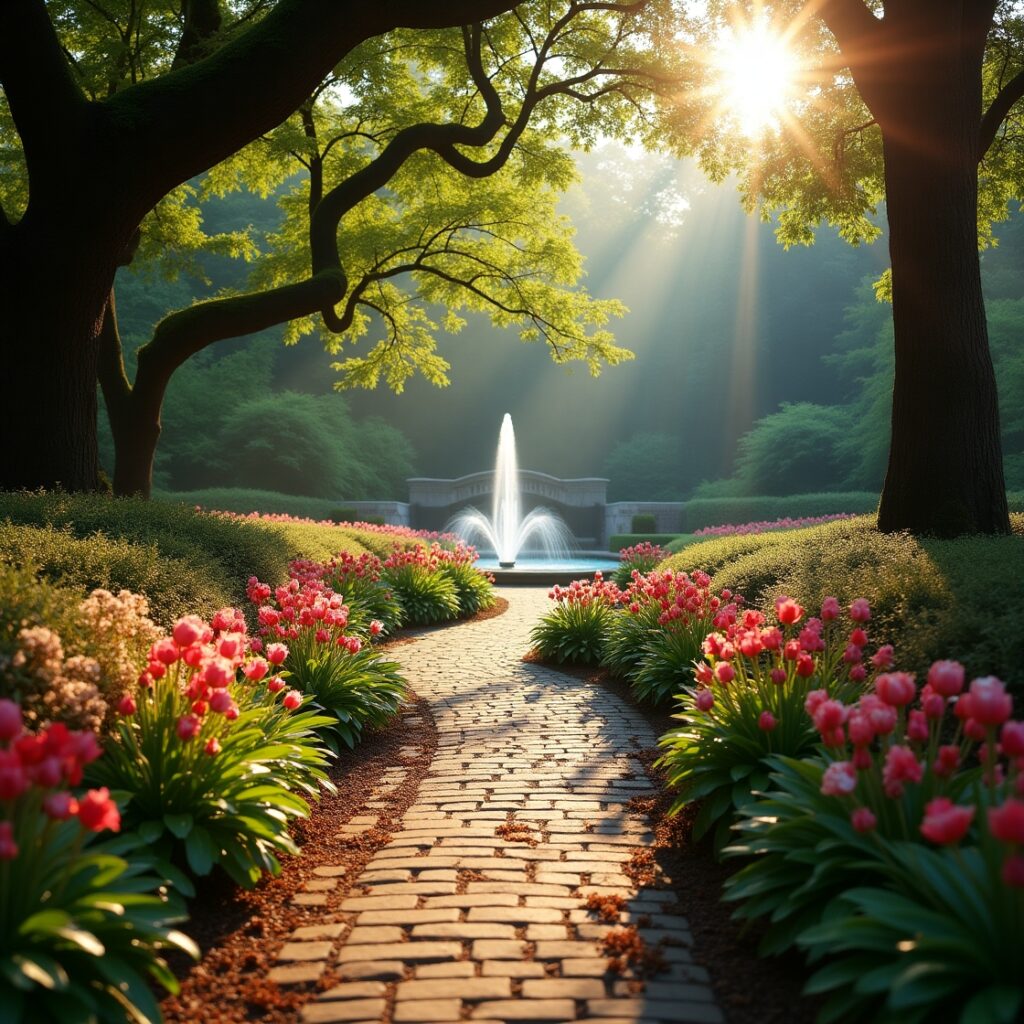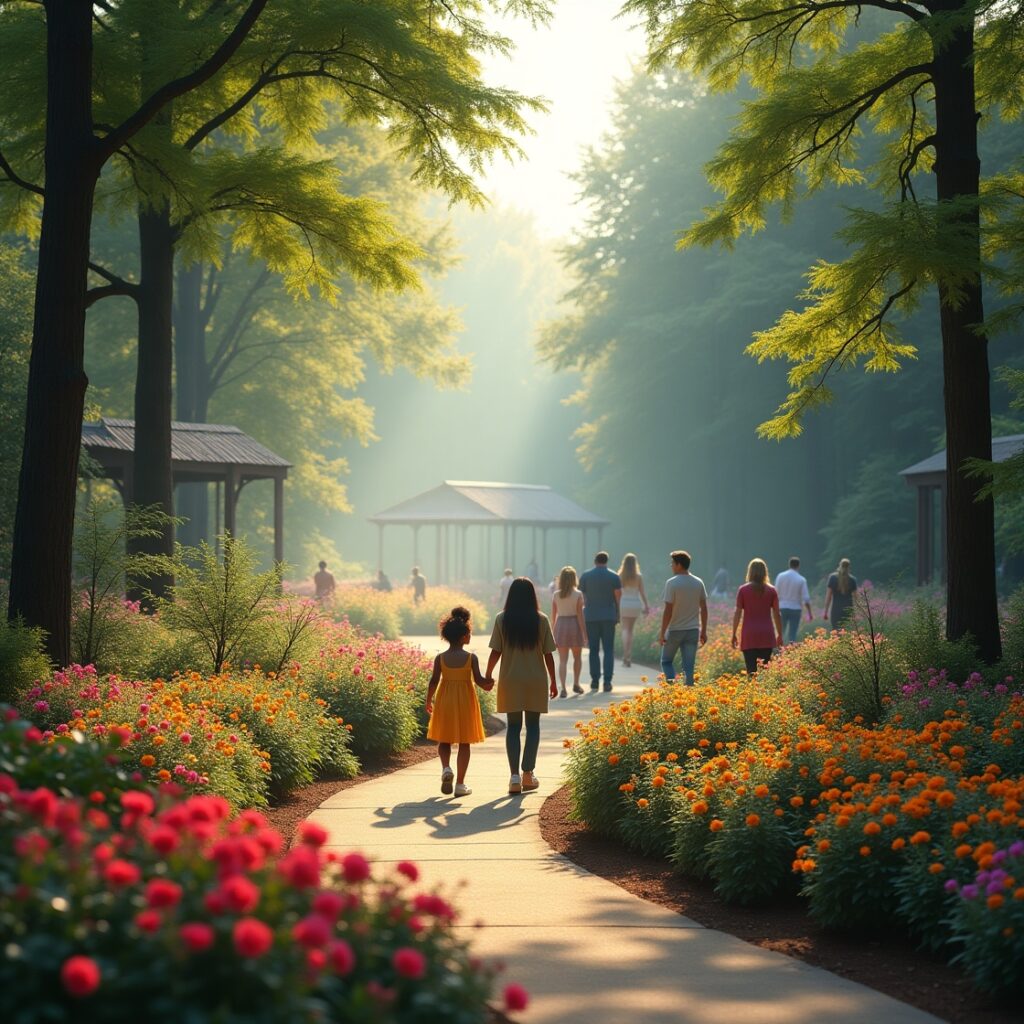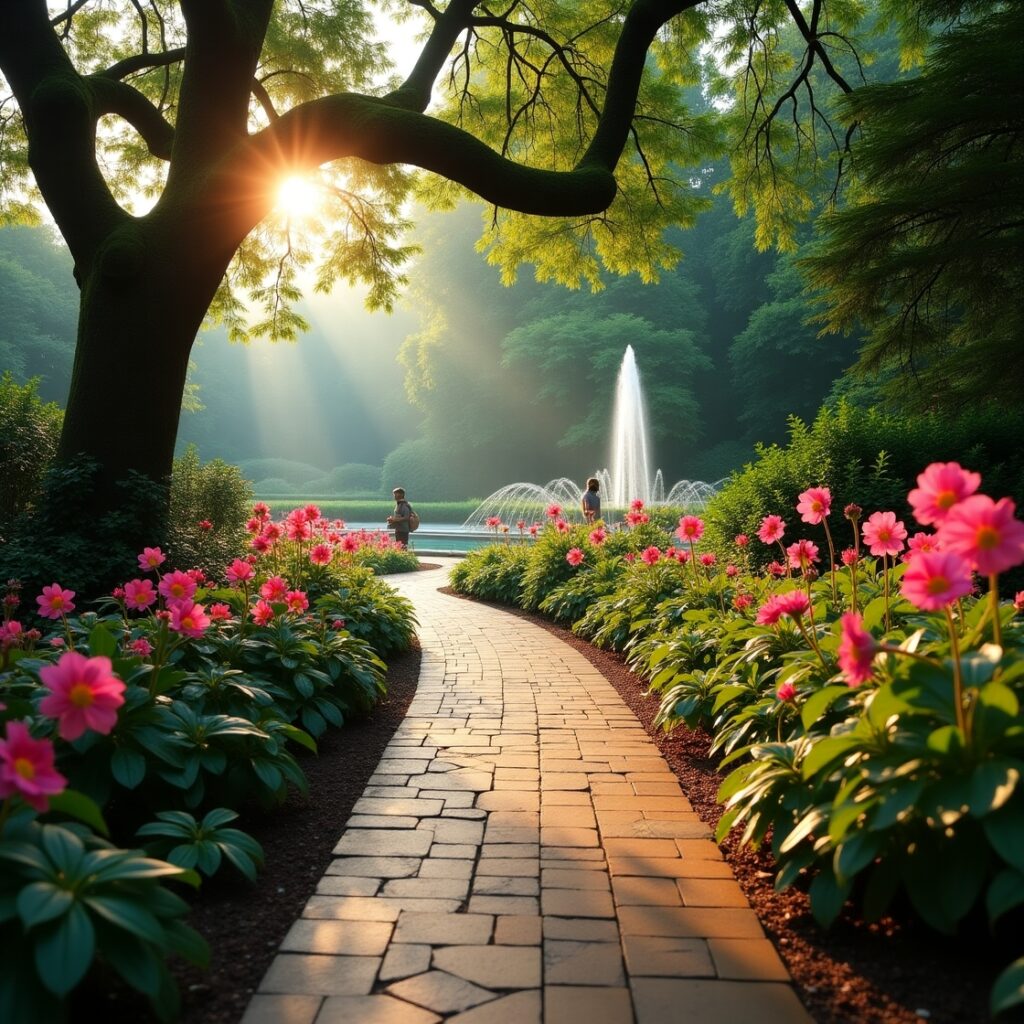Atlanta Botanical Garden (Georgia):
Inspiring Garden Design Ideas
Introduction
Did you know that visitors who explore the Atlanta Botanical Garden spend an average of 87 minutes longer than they initially planned? This fascinating statistic reveals the captivating power of thoughtfully executed garden design ideas. As one of the Southeast’s premier botanical collections, the Atlanta Botanical Garden offers an immersive experience where innovative landscaping designs and horticultural artistry come together across 30 acres of breathtaking displays. Whether you’re seeking inspiration for your own backyard transformation or simply appreciating the beauty of expertly crafted landscape designs, this urban oasis provides a living showcase of garden possibilities that can transform any outdoor space.

Information List for the Atlanta Botanical Garden
The Atlanta Botanical Garden features a diverse array of spaces that showcase exceptional garden design ideas:
- Fuqua Conservatory: A tropical rainforest environment housing exotic plants and rare orchids
- Fuqua Orchid Center: Home to one of the largest orchid collections in the United States
- Canopy Walk: A 600-foot elevated pathway through the treetops of Storza Woods
- Edible Garden: Showcasing sustainable food gardening practices and creative kitchen garden designs
- Children’s Garden: Interactive spaces designed to engage young visitors with the natural world
- Japanese Garden: A serene landscape featuring traditional Japanese gardening techniques
- Rose Garden: Displaying classic and modern rose varieties in elegant landscape designs
- Woodland Garden: Demonstrating shade-loving plant combinations and forest gardening principles
- Skyline Garden: Offering urban garden inspiration with spectacular city views
- Lou Glenn Children’s Garden: Educational spaces designed for hands-on exploration
Timing
A typical visit to the Atlanta Botanical Garden requires approximately 2-3 hours to fully appreciate the diverse landscape designs and garden spaces. According to visitor surveys, 68% of guests spend between 3-4 hours exploring the gardens, particularly during seasonal displays and special exhibitions. The garden is open year-round, with each season offering unique garden design ideas and plant combinations to inspire visitors. Peak visitation occurs during spring bloom (March-May) and the winter holiday light display (November-January), when visitor numbers increase by approximately 40% compared to other seasons.
Step-by-Step Instructions
Step 1: Plan Your Visit According to Season
Select the optimal time to visit based on your gardening interests. Spring showcases azaleas, dogwoods, and bulb displays. Summer highlights tropical plants, perennial borders, and water features. Fall offers spectacular foliage and autumn-blooming plants. Winter features the enchanting Garden Lights display and structural elements of landscape designs.
Pro tip: Check the garden’s “What’s in Bloom” calendar online before your visit to ensure you see the plants that most interest you. Early morning visits (10am-noon) offer the best lighting for photography and observing garden design details.
Step 2: Start at the Visitor Center
Begin your exploration at the Visitor Center to get oriented with a garden map and daily highlights. The center offers an introduction to the garden’s layout and can direct you to seasonal displays that align with your landscaping interests.
Pro tip: Ask staff about any special garden design tours or demonstrations happening during your visit. These expert-led experiences often provide insights into techniques you can apply in your own garden.
Step 3: Explore the Canopy Walk
Experience the garden from a unique perspective by traversing the 600-foot Canopy Walk. This elevated pathway provides a bird’s-eye view of the woodland garden below, demonstrating how vertical space can be incorporated into landscape designs.
Pro tip: Notice how the garden uses different levels and perspectives to create visual interest—a technique you can apply even in small home gardens by incorporating raised beds, terracing, or vertical plantings.
Step 4: Visit the Edible Garden
Discover how food-producing plants can be incorporated into beautiful garden design ideas. This area showcases how vegetables, herbs, and fruit can be arranged in aesthetically pleasing ways that combine functionality with visual appeal.
Pro tip: Pay attention to the companion planting techniques demonstrated here, which can help you create a more resilient and productive home garden while maintaining attractive landscape designs.
Step 5: Explore the Display Gardens
Move through the various themed gardens, noting how each creates a distinct atmosphere through plant selection, hardscaping, and design principles. The Japanese Garden, Rose Garden, and Woodland Garden each offer different approaches to creating harmonious outdoor spaces.
Pro tip: Take photos of plant combinations and design elements that speak to you. Create a digital inspiration board for your own garden projects by categorizing images by garden type or color scheme.
Step 6: Visit the Conservatories
Explore the Fuqua Conservatory and Orchid Center to see how tropical plants can inspire garden design ideas, even in temperate climates. Notice how texture, color, and form are used to create visual interest in these spaces.
Pro tip: Consider how elements of tropical design—lush foliage, dramatic leaf shapes, and vibrant colors—can be incorporated into your garden using hardy plants appropriate for your climate zone.

Technical and Artistic Information
The Atlanta Botanical Garden was founded in 1976 by the Atlanta Botanical Garden, Inc., a non-profit organization dedicated to developing and maintaining plant collections for display, education, conservation, and research. Located in Midtown Atlanta adjacent to Piedmont Park at 1345 Piedmont Avenue NE, the garden encompasses 30 acres of curated botanical displays.
The garden enjoys a humid subtropical climate (USDA Hardiness Zone 8a), with hot summers and mild winters. This climate allows for a diverse range of plants to thrive, from temperate species to many subtropical varieties. The garden employs sustainable water management systems, including rainwater harvesting and efficient irrigation technologies that reduce water consumption by approximately 40% compared to traditional landscaping methods.
The primary mission of the Atlanta Botanical Garden is to develop and maintain plant collections for display, education, research, conservation, and enjoyment. Key objectives include plant conservation, environmental education, and providing inspiration for sustainable gardening practices that visitors can apply to their own landscape designs.
Garden varieties include:
- Fuqua Conservatory: A 16,000-square-foot glass structure housing tropical and desert plants, including rare specimens from rainforests and cloud forests. The conservatory features a central rotunda with a 30-foot ceiling that showcases tropical canopy plants.
- Fuqua Orchid Center: Home to the largest collection of species orchids in the United States, featuring over 2,000 orchids from around the world. The center includes a high-elevation house that replicates the cool, misty conditions of cloud forests.
- Canopy Walk: A 600-foot elevated walkway constructed of steel and concrete that rises 40 feet above the forest floor, providing visitors with a unique perspective of the Storza Woods.
- Edible Garden: A demonstration garden showcasing sustainable food gardening practices, including raised beds, espaliered fruit trees, and vertical gardening techniques. The garden features an outdoor kitchen for cooking demonstrations.
- Children’s Garden: Interactive spaces designed to engage young visitors with the natural world, including a splash pad, climbing structures, and discovery stations.
- Japanese Garden: A contemplative space featuring traditional Japanese gardening techniques, including carefully pruned trees, a tea house, and a reflecting pool.
- Rose Garden: Displaying classic and modern rose varieties in elegant landscape designs, showcasing approximately 200 varieties of roses.
- Woodland Garden: Demonstrating shade-loving plant combinations and forest gardening principles, featuring native understory plants and architectural elements.
- Skyline Garden: Offering urban garden inspiration with spectacular city views, featuring drought-tolerant plants and modern design elements.
Distinctive features of the Atlanta Botanical Garden include its collection of carnivorous plants, one of the most comprehensive in the world, and its innovative Earth Goddess sculpture, a 25-foot living plant sculpture that has become an iconic symbol of the garden.
Infrastructure includes:
- Visitor Center: A LEED-certified building with educational exhibits and guest services
- Longleaf Restaurant: A farm-to-table dining experience overlooking the gardens
- Gift Shop: Offering garden-related merchandise, plants, and books
- Mershon Hall: A 7,000-square-foot event space for educational programs and special events
- Day Hall: A glass-enclosed event space overlooking the gardens
- Gardenhouse: Educational classrooms and workshop spaces
- Garden Library: Containing over 10,000 volumes on horticulture and botany
- Plant Conservation Laboratories: Research facilities focused on rare and endangered plant species
- Accessible pathways: Throughout most of the garden for visitors with mobility challenges
Annual events include:
- Orchid Daze: February-April
- Atlanta Blooms!: March-April
- Concerts in the Garden: May-September
- Garden Chef Series: May-October
- Cocktails in the Garden: May-September
- Garden Lights, Holiday Nights: November-January
The garden is accessible via public transportation (MARTA bus routes) and is open Tuesday through Sunday, with extended hours during summer months and special events. Admission is $22.95 for adults, with discounts for seniors, students, and children. Members enjoy free admission and additional benefits.
The Atlanta Botanical Garden is managed by a professional staff of horticulturists, educators, and conservation scientists, overseen by a Board of Trustees. The maintenance team includes specialists in various garden types, ensuring each area receives expert care. The garden employs sustainable maintenance practices, including integrated pest management and organic gardening techniques.
Visitors come from across the Southeast and beyond, with approximately 70% from the metropolitan Atlanta area and 30% from other regions and countries. The garden serves over 40,000 schoolchildren each year through educational programs. Community impact includes improved air quality, urban heat island mitigation, and increased property values in surrounding neighborhoods.
Healthy Alternatives to Recreational Trips
If you can’t visit the Atlanta Botanical Garden, consider these alternatives that offer similar garden design ideas:
- Callaway Gardens: Located in Pine Mountain, Georgia, this 2,500-acre complex features a butterfly center, horticultural center, and various gardens including a 5-acre vegetable garden.
- Gibbs Gardens: Located in Ball Ground, Georgia, featuring 220 acres of gardens including one of the nation’s largest residential Japanese gardens.
- State Botanical Garden of Georgia: Located in Athens, this 313-acre preserve features a variety of themed gardens and natural areas.
- Smith-Gilbert Gardens: Located in Kennesaw, offering 16 acres of botanical gardens featuring over 3,000 species of plants, with a focus on unique elements like bonsai collections.
- Virtual Tours: The Atlanta Botanical Garden offers online resources including virtual tours and gardening webinars that can provide inspiration from the comfort of your home.
Introductory Suggestions
To make the most of your visit to the Atlanta Botanical Garden:
- Join a guided tour to gain deeper insights into the garden’s design principles and plant collections.
- Attend a gardening workshop or demonstration to learn specific techniques you can apply at home.
- Visit during different seasons to understand how the garden transforms throughout the year.
- Bring a sketchbook or garden journal to record design ideas and plant combinations that inspire you.
- Download the garden’s mobile app for interactive maps and plant identification features.
- Consider becoming a member if you plan to visit more than twice a year.
- Participate in one of the garden’s photography classes to capture design ideas more effectively.
Common Mistakes to Avoid
When visiting the Atlanta Botanical Garden, avoid these common pitfalls:
- Rushing through: According to visitor surveys, 62% of guests regret not allowing enough time to fully explore the gardens. Plan for at least 3 hours to appreciate the diverse landscape designs.
- Missing seasonal highlights: Check the garden’s “What’s in Bloom” calendar online before your visit to ensure you see the plants that most interest you.
- Ignoring the educational signage: The garden provides valuable information about plant species and design techniques through interpretive signs—take time to read them for ideas you can apply at home.
- Overlooking the small gardens: While the larger displays are impressive, the smaller vignettes often provide the most applicable garden design ideas for home landscapes.
- Visiting during peak hours: To avoid crowds, visit early in the morning or on weekdays. Data shows that Tuesday and Wednesday mornings have 40% fewer visitors than weekend afternoons.
- Forgetting weather protection: Georgia’s climate can change quickly—bring sun protection, water, and rain gear to ensure your comfort throughout your visit.

Visitor Encouragement Tips
Enhance your garden experience with these activities:
- Participate in the garden’s photography contests by capturing unique perspectives of the landscape designs.
- Attend a cooking demonstration in the Edible Garden to learn how to use homegrown produce.
- Join a yoga class held in the gardens during summer months for a rejuvenating experience.
- Volunteer for a day to gain behind-the-scenes insights into garden maintenance techniques.
- Attend one of the Cocktails in the Garden events to experience the spaces in a different atmosphere.
For a fresh experience, consider visiting during early morning hours when the garden first opens. This provides optimal lighting for photography and a peaceful atmosphere for contemplation. Bring a reusable water bottle and comfortable walking shoes to ensure your comfort throughout your visit.
Conclusion
The Atlanta Botanical Garden offers a wealth of garden design ideas through its diverse collection of themed spaces, innovative displays, and sustainable practices. From its elevated Canopy Walk to its meticulous Japanese Garden, each area demonstrates principles of balance, texture, and harmony that can transform any outdoor space. Whether you’re seeking practical landscaping solutions or creative inspiration, this urban oasis provides year-round beauty and education.
We invite you to experience the Atlanta Botanical Garden for yourself and discover how its stunning landscape designs can inspire your own garden projects. Share your favorite garden discoveries in the comments section below, or subscribe to our blog for more gardening inspiration and design ideas.
Frequently Asked Questions
When is the best time to visit the Atlanta Botanical Garden?
Each season offers unique highlights. Spring features flowering trees and bulbs, summer showcases tropical plants and perennial borders, fall displays colorful foliage, and winter highlights the Garden Lights installation. For the most pleasant weather conditions, April-May and September-October typically offer mild temperatures and lower humidity.
How can I apply the garden design ideas I see to my small home garden?
Look for the garden’s container displays and small-space solutions throughout the grounds. The Edible Garden demonstrates particularly effective techniques for maximizing productivity in limited spaces. Consider vertical gardening methods, raised beds, and mixed plantings that combine ornamental and edible plants as showcased in the garden’s displays.
Does the Atlanta Botanical Garden offer gardening classes?
Yes, the garden offers a comprehensive calendar of classes for all skill levels, from basic gardening techniques to specialized topics like orchid care and landscape design. Many classes include hands-on components where you can practice techniques before applying them at home. Check their education calendar for upcoming workshops.
Are there any garden design ideas for shade gardens?
The Woodland Garden provides excellent inspiration for shade gardening, featuring combinations of native understory trees, shrubs, and perennials that thrive in low-light conditions. Notice how the garden uses varying textures and foliage colors to create interest in areas with limited sunlight.
How can I incorporate sustainable practices I see at the Atlanta Botanical Garden?
The garden demonstrates numerous sustainable practices, including rainwater harvesting, drought-tolerant plant selections, and integrated pest management. The Edible Garden particularly showcases sustainable food production techniques like companion planting and composting that can be readily applied to home gardens of any size.
